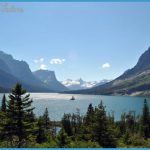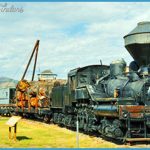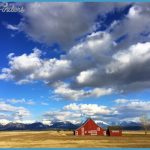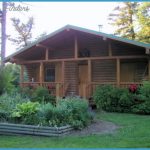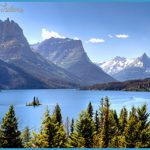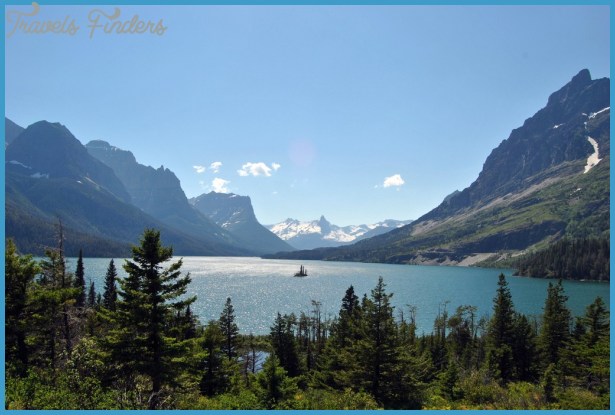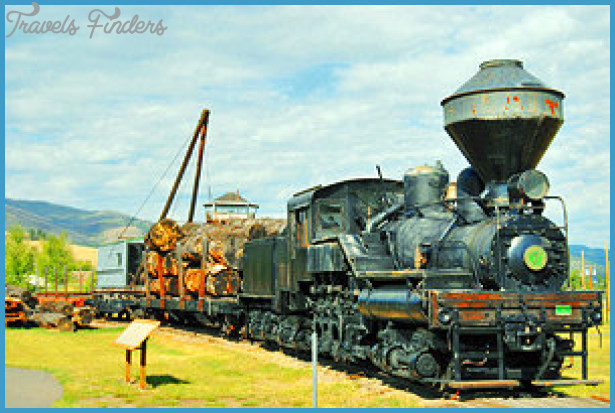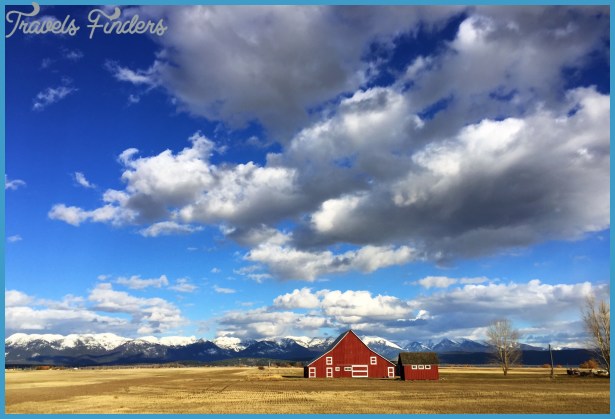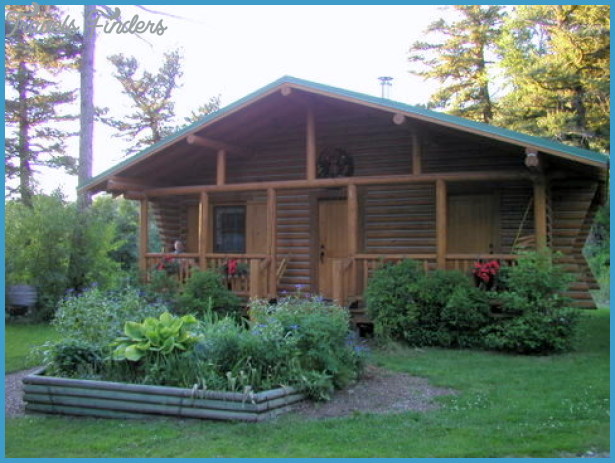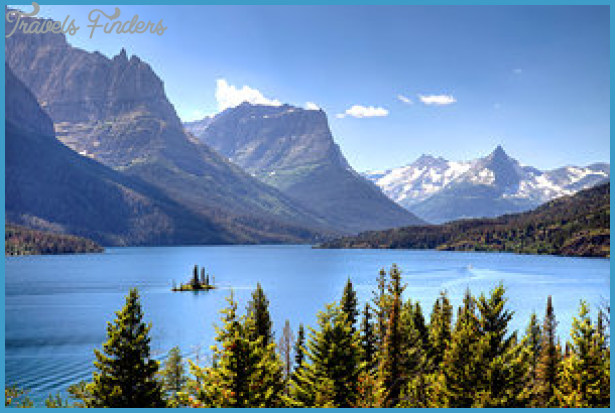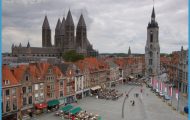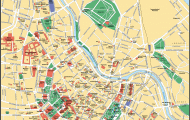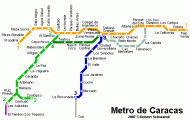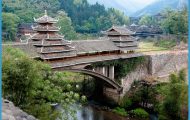THE HIGH POINT ON THE OFF-THE-GRID ROAD BETWEEN YAAK AND LIBBY
Soon after, the road widens you’ll arrive at the Red Dog and Libby, which will seem like a metropolis after spending time in the Yaak.
Troy Montana Log Cabins ($/$$, 406-295-5810), on a slight perch about a half-mile west of town, has four clean and comfortable cabins, two that sleep up to eight and two others that are slightly smaller. All four have all the basic amenities. A fifth cabin has three bedrooms, two bathrooms, and a Jacuzzi tub.
Alternative Places to Bunk
Troy: The City of Troy ($, 406-295-4151) seasonally rents a five-person yurt on the Kootenai River for $50/night. Bring your sense of adventure along with your bedding, food, and dishes. Kootenai River Campgrounds (406-295-4090, May-Oct) has five tent sites and 25 RV sites in the pines on the river. They also have four cabins with bedding, electricity, and a fridge; three of them sleep two for $35/night and one larger one sleeps seven for $60. By the way, they haven’t raised their prices in years! forest service cabins/lookouts (Reservations: 877-444-6777 or www.recreation.gov.): You’ve heard of rooms with a view? For views with a room, rent a forest fire lookout tower. In the Kootenai National Forest (406-293-6211) there are more for rent than on any forest in the Pacific Northwest nine in all, including seven accessed from the Yaak-Koocanusa Route: The 45-foot-high Yaak Mountain Lookout ($35/sleeps four) near Troy, 41-foot Big Creek Baldy Lookout ($40/sleeps four) near Turner Mountain Ski Area, 40-foot Mount Baldy/Buckhorn Ridge Lookout ($35/sleeps four) west of Yaak, and 40-foot Garver Mountain Lookout ($35/sleeps four) northwest of Yaak.
For cabins, primitive McGuire Mountain ($25/sleeps four) off MT 37 between Libby and Rexford has views of Lake Koocanusa and the Purcell Mountains, the spacious Upper Ford Ranger Station ($50/sleeps seven) just northeast of Yaak is accessible year-round on pavement, and Webb Mountain Lookout ($35/sleeps five) is a cabin 10 feet off the ground with views of Lake Koocanusa as well as Glacier National Park’s highest peaks. Most lookouts and cabins are equipped with spartan beds, mattresses, and propane cook stoves. Some cabins are equipped with bathrooms, but the towers only have separate one-holers. These are extremely popular, especially in summer. It’s wise to book well in advance.
Best Eats
Libby: The only town on the route with the usual fast-food suspects, Libby also provides some diversity. The best breakfast stop in town is the Libby Cafe ($, 406-293-3523, B/L), popular for its Montana Muffins (which can be shipped back home). Like many bakeries in Montana, the Libby Cafe takes advantage of the state’s most famous local berry: the huckleberry, which only grows in the wild. Red Dog Saloon & Pizza ($/$$, 406-293-8347, D, closed Tuesdays in winter), north of town on the way to Turner Mountain Ski Area, is a quintessential community gossip, peanut shells on the floor kinda bar and eatery with decent pizza to boot. The menu has a wide variety and everything’s tasty. They’re always busy, so you might have to park on the other side of the road. Also worth a try is the rustic Antlers ($$, 406-293-6464, B/L/D), which has a little bit of everything American. troy: Jack’s Cafe ($, 406-295-4352, B/L) does little on the exterior to coax you in (and offers nothing special on the interior, for that matter). Oh, and the owner, Kathy, who’s been cooking there since the 1960s, can be a bit crusty. But can she ever cook! And you won’t believe the prices. Breakfasts are what you’d expect no trimmings, but they cost around $5. Friday night prime-rib dinners bring folks out of the woods. If you show up late, you’re probably out of luck and will just have to come back for breakfast.
Yaak: If it’s deep fried deliciousness you’re after, you’ll find it at the Yaak River Tavern and Mercantile ($, 406-295-4706, L/D) steak, chicken, fish, gizzards, pickles you name it. And then there’s the nachos (chips or tots), fries dripping in cheese n chili, flatbread pizzas, and even green salads. If you’re lucky there’ll be a pot of homemade soup or smoked and grilled specialties such as brisket or ribs. No matter what they’ve got cooking, you won’t go away hungry, and you might get to hear about the latest Sasquatch sighting from the regulars unwinding on the wagon wheel bench out front. An outdoor music stage adds to the experience.
Best Bar
Time was, the Dirty Shame Saloon (406-295-5100) was one of the roughest, toughest, gnarliest bars in all of Montana. Loggers, shut-ins, gritty Forest Service workers, tattooed bikers, and even airmen from the now-defunct Yaak Air Force Base stumbled into the remote bar after hours, all looking for a stiff drink and, in many cases, a fight. The saloon’s name was reportedly coined by one of the airmen who frequented what was then called the Yaak iver Lodge. It was, he said, a dirty shame that the place looked nothing like an actual lodge. Another legend has it that the great boxer Joe Louis once ordered a scotch at the bar, and when told they didn’t have it, he reputedly replied, That’s a dirty shame. Why or if Joe Louis was actually in Yaak is lost to the dustbin of history. These days, John Runkle, owner of the Yaak River Lodge, owns The World Famous Dirty Shame. He bought it out of foreclosure after the previous owner, a Maryland preacher, ran into some legal issues back home. Much to the chagrin of many locals, he had completely tamed the place, turning it into a family-friendly bistro a theme that didn’t align with the names carved into the planks, the bullets embedded in the walls, and a onetime owner who liked to shoot pool balls off the table with a pistol. Runkle is determined to restore a semblance of its previous unfettered heyday, minus the gunplay. Included in the plans are the return of the annual Crawdad Festival, Halloween costume galas, Monday night football parties, and re-emphasizing Harley Davidson orange.
DETOUR: ONE FOR THE ROAD
The Clark Fork Valley St. Regis to Troy
ESTIMATED LENGTH: 134 miles highlights: Quinn’s Hot Springs Resort, Noxon Reservoir, Ross Giant Cedars getting there: St. Regis is about an hour northwest of Missoula on I-90. Take the MT 135 exit and begin the journey along the Clark Fork as it winds through the mountains toward its eventual end in Idaho’s Lake Pend Oreille.
The official name of the broad river that serpentines through forests of ponderosa, lodgepole, larch, fir and spruce is the Clark Fork of the Columbia River, because Arlo Guthrie’s famous hard-working river is its ultimate destination. The Clark Fork begins its life as Silver Bow Creek in Butte and collects enough mountain water while following I-90 to become a behemoth by St. Regis, where it leaves the interstate and briefly backtracks to the east before renewing its commitment to reaching Idaho. The entire drive is picturesque and is dotted with friendly little communities that beckon with cafes, ice cream stands, and inviting mom-and-pop motels.
St. Regis (pop. 319) is an old logging and mining community where the St. Regis River finishes its descent from the Bitterroot Mountains to the Clark Fork. Today it is playing well as a jumping-off point for tourists headed north to Glacier country and the Flathead region. Its primary claim to fame is Montana’s largest flea market, which takes place over Memorial Day weekend. Popular for folks gassing up for the I-90 climb toward Lookout Pass on the Montana-Idaho border is the St. Regis Travel Center, which features a large trout aquarium.
MT 135 cuts for 25 miles through a weak spot in the Coeur d’Alene Range on the St. Regis-Paradise Scenic Byway toward Paradise (pop. 210), which sits at the junction of two railroads, the Clark Fork and Flathead Rivers, and three mountain ranges. Just before Paradise is Quinn’s Hot Springs Resort (406-826-3150), which has six pools (including four soaking pools) in a pine-studded setting with 10 pet-friendly cabins (some with Clark Fork views), a lodge, suites, tavern, and a restaurant. Quinn’s, open all year, is also known for its Montana Baroque Music Festival each July.
At Paradise, the road meets MT 200 and the Clark Fork becomes brawny with the addition of the Flathead River’s waters. From here, you’ll explore a series of logging and railroad communities that have evolved to exploit the numerous outdoor-recreation options in their backyards. Five miles up the road is Plains (pop. 1,064), once called Wild Horse Plains because Indians wintered their horses here. Plains has an appealing assortment of cafes, an ice cream stand and a charming little motel called the Dew Duck Inn. Signs along the highway caution travelers to look for bighorn sheep that cling to the rocky ridges of the Cabinet Mountains and occasionally wander onto the highway. The best place to see these majestic mountain creatures is the Koo-Koo-Sint Bighorn Sheep Viewing Site, a pullout with interpretive signs along the road near a field where the sheep frequently linger. Prime viewing time is in the autumn, when as many as 100 bighorns congregate. If you’re lucky, you’ll see rams in the annual rut battering each other with their distinctive curled horns, all in an effort to impress the neighborhood ewes.
A MOOSE COOLS OFF IN THE MEANDERING BULL RIVER
Thompson Falls (pop. 1,338) was built for logging at the edge of a natural falls on the Clark Fork. Once upon a time, residents forced trains to stop here by putting logs on the Northern Pacific Railroad tracks. Now a dam has mostly inundated the falls and the locals are subtler, coaxing tourists to stop along the main drag using their cafes especially Minnie’s and appealing lodging, and plenty of quaint shops for browsing. Just outside of town, Thompson Falls State Park is in a shaded, pleasant setting along the river, perfect for a picnic, fishing for trout in the small pond, or to camp as a base for exploring the surrounding mountains. If you’re inclined to make this a more leisurely drive, leave MT 200 at Thompson Falls before the highway crosses and river and take Blue Slide Road as it slithers along the north bank.
Another 22 miles down the road is the recreation haven of Trout Creek (pop. 242), which marks the beginning of Noxon Reservoir. Trout Creek is a busy little place with a couple of marinas where motorboaters launch onto the fishing-rich waters of the reservoir. Nightlife here revolves around the cleverly named Naughty Pine Saloon and a St. Louis Cardinals-oriented sports bar with indoor and outdoor seating called the Way Side that’s known for its homemade pizza dough and special sauces. The bartender/cook once lived in Seattle and has brought a taste of the Emerald City veggie-oriented entrees, for instance to Trout Creek. The Lakeside Motel & Resort, which has a bar, cabins for rent above the reservoir, and a restaurant popular for its steaks and fried chicken, is constantly abuzz with activity.
At Trout Creek, MT 200 re-crosses the reservoir and passes a U-pick blueberry farm hidden in the hills before arriving at the turnoff for Noxon (pop. 218). It’s a lengthy drive across a one-lane bridge to the town, which is out of sight and out of mind for most tourists. Noxon does have a general store, tavern, and a grill open for lunch and dinner. Back on MT 200, for a supper-club atmosphere, there’s the Hereford Restaurant & Cocktail Bar, a dark log structure tucked amid tall cedars. The menu runs the gamut from handcrafted pizzas, nachos, and wings to rib-eye steaks. And at Heron, which marks the junction with MT 56, or Bull River Road, the Big Sky Pantry has fresh-baked breads, cookies, desserts, ice cream, deli sandwiches, and farm-to-table meals.
Turn right on Bull River Road and follow the river as it winds along the western flanks of the Cabinet Mountains, providing periodic spectacular views. Look for moose in the meandering Bull River. Just before Bull Lake, you’ll arrive at the turn for the 100-acre Ross Creek Cedars Scenic Area, which boasts 1,000-year-old trees with trunks as thick as 12 feet in diameter. Tucked in a gulch in what passes for a rain forest in Montana, these western red cedars clearly are survivors, having emerged unscathed from the scorching fires of 1910 and staring down flames again in the scorching summer of 2015 before Mother Nature provided 11th-hour clemency. The trees along the flat 1 mile-long interpretive trail are nearly as impressive as California’s redwoods, and so are the thousands of human-made cairns rising from logs, bare ground, and the river rock course of Ross Creek. The road into the cedars is one lane but paved with pullouts. Bull Lake has a couple of campgrounds and lodging options, including the rustic and affordable Bull Lake Guest Ranch. Enjoy the views of the Cabinets the rest of the way to the junction of US 2 and Troy.

